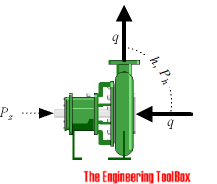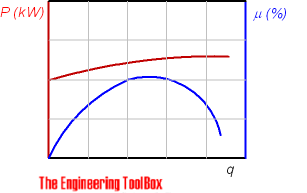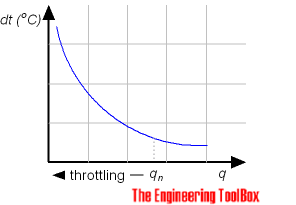Pump - Temperature Rise vs. Volume Flow
Calculate temperature rise vs. volume flow in pumps.
No pump is perfect with 100% efficiency. Energy lost in friction and hydraulic losses transforms to heat - heating up the fluid transported through the pump.

The temperature rise can be calculated as
dt = Ps (1 - μ) / (cp q ρ) (1)
where
dt = temperature rise in the pump (oC)
q = volume flow through pump (m3/s)
Ps = brake power (kW)
cp = specific heat of the fluid (kJ/kgoC)
μ = pump efficiency
ρ = fluid density (kg/m3)
A typical relation between flow, efficiency and power consumption for a centrifugal pump:

Pump - Temperature Rise Calculator
Example - Temperature rise in water pump
Temperature rise in a water pump working at normal conditions with flow 6 m3/h (0.0017 m3/s), brake power 0.11 kW and pump efficiency of 28% (0.28) can be calculated as
dt = (0.11 kW) (1 - 0.28) / ((4.2 kJ/kgoC) (0.0017 m3/s) (1000 kg/m3))
= 0.011 oC
Specific heat of water cp = 4.2 kJ/kgoC.
If the flow through the pump is reduced by throttling the discharge valve the temperature rise increase. If the flow is reduced to 2 m3/h (0.00056 m3/s), brake power slightly reduced to 0.095 kW and the pump efficiency reduced to 15% (0.15) - the temperature rise can be calculated as
dt = (0.095 kW) (1 - 0.15) / ((4.2 kJ/kgoC) (0.00056 m3/s) (1000 kg/m3))
= 0.035 oC
With manufacturing documentation the temperature rise versus throttling can be expressed as:




